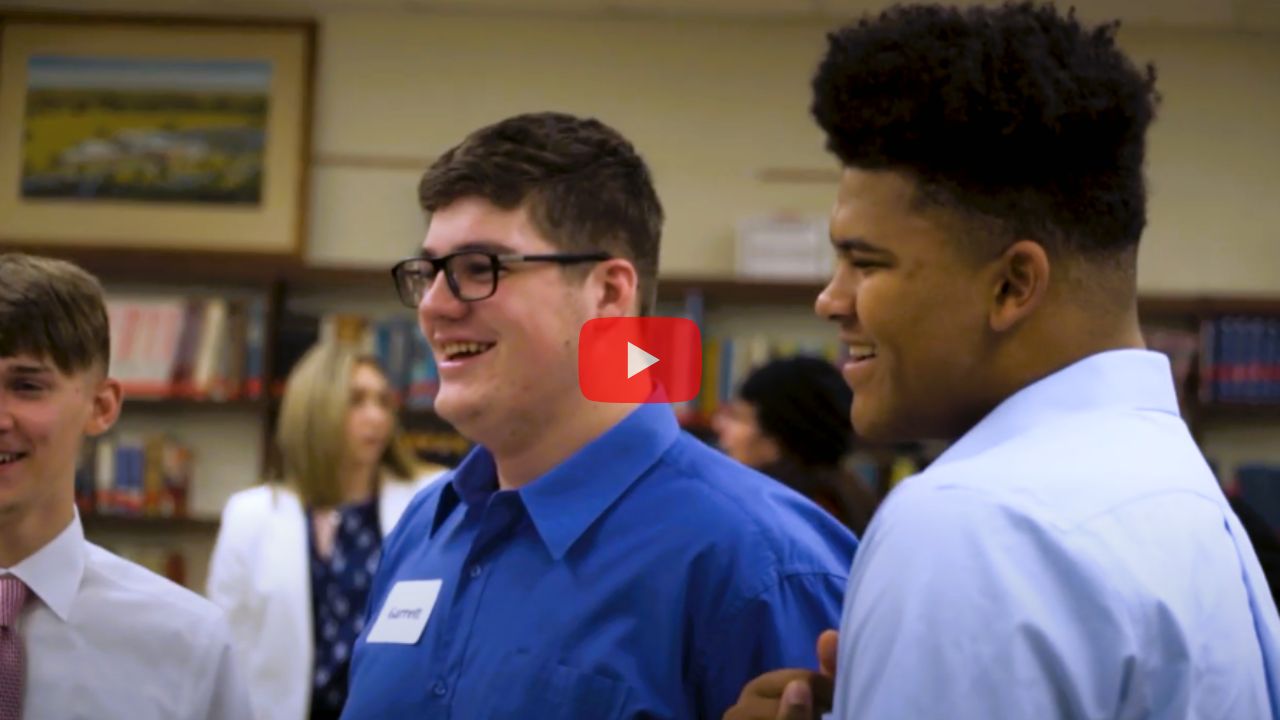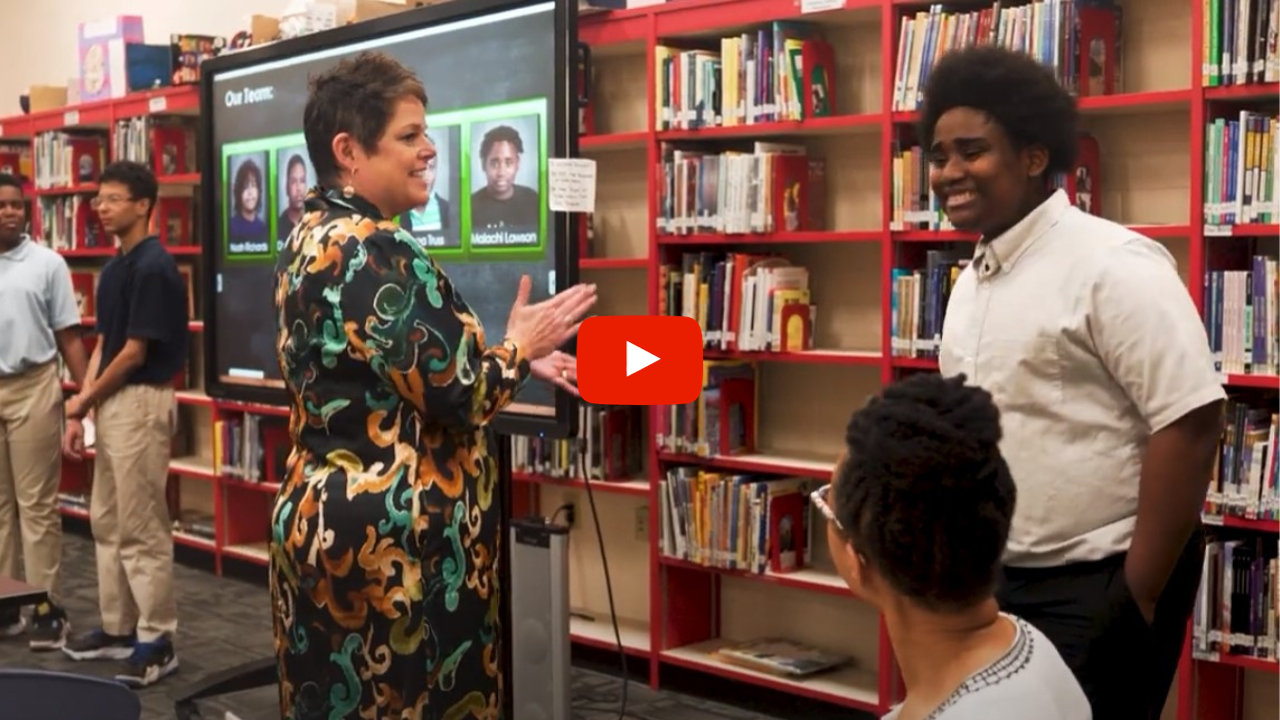In this episode, Doris recalls the process of designing and building Hawken’s Entrepreneurial Studies program in a high school and why using real business problems should be core to entrepreneurship programs. Doris and Tim also discuss the role of the Lean LaunchPad Methodology and Design Thinking and why it’s so important to “get out of the building.”
Tim: When you were planning this program, I know there were two schools of thought that you were intentional in sort of incorporating into building this, and those were Lean LaunchPad and Design Thinking.
I thought maybe we could talk a little bit about the elements of each of those and how we use those in the course, how we’ve adapted them, how we’ve changed them, altered them; any of that sort of thing.
Doris: I’ll actually say it a little differently than you just said it. When I first started planning this, I wanted to build an entrepreneurship class where students learn skills and knowledge by working on real problems on teams. That’s really what I wanted.
I did some research my first year. I looked around and I learned some stuff about Design Thinking. And since then, it’s developed quite well. They’ve got some educators toolkit stuff, which is really nice.
I actually hadn’t heard yet about Lean LaunchPad. That didn’t come till later. There was a teacher that I hired at one point who had done a Startup Weekend. She came across Lean LaunchPad during that and said, “Hey, we should look at this.”
We went to a workshop. I met Steve Blank at a workshop. I had not been aware of it until then. As you know, I did a Startup Weekend with you, actually.
Tim: Yes.
Doris: And we learned. When I scoured the scene, this was before anybody, before there was anything. When I . . .
Tim: This is what year, approximately?
Doris: Well, I’ve been here four-and-a-half years, so this was 2011, 2012. I was literally – for that year, I was doing two things. I was planning the major elements of the course and I was looking around at what there was.
I also learn by doing, and when I design a new course, I know that most of the design work happens when you’re actually teaching it. There’s only so much you can – you know this.
Tim: Right.
Doris: There’s only so much you can set up ahead of time. So I researched that year where there were entrepreneurship programs. What I found was very little, actually, that I considered entrepreneurship. Hardly anything.
This was five years ago, four-and-a-half years ago. At the graduate school level, I did find some programs that were called entrepreneurship programs. When I looked into what they were, they were almost entirely spray-painted MBA programs. They were still how to write a business plan, read this case study, let’s talk about blah, blah, blah; maybe there were some small business approach things.
I found very little that fit how to turn ideas into successful realities; all this stuff that I learned about entrepreneurship. In the software days, I didn’t find much. The undergraduate level, I really didn’t find anything. And at the K12 level, wow, did I not find anything.
So I either found what Steve Blank refers to as “how to build a lemonade stand,” where there was some project somebody was doing to start, you know, my mom has a great chocolate chip cookie recipe, and I’m going to sell them at the corner, or . . .
Tim: Or selling pencils on the school store model, right? That kind of thing.
Doris: That’s right. Selling pencils. Although I have to say, back then, there wasn’t even a lot of that. Now it feels like, oh, everybody has an entrepreneurship program and there are pitch competitions all over the place. That’s really been very recent that that stuff has developed. So I didn’t see a whole lot.
The reality is other people had started to hear about Lean LaunchPad. I had not yet. It was very early for Steve Blank and those guys as well. So we dove in.
What I was very, very focused on was finding the real business problems and structuring those and how we would set up the problem-solving so that the learning would happen, the learning along the way, and what were the kinds of assignments and materials and research they could find along the way, et cetera.
That’s where my head was. Having taught for many years, I was really thinking about what should those problems look like, and then how do we guide the learning along the way, et cetera.
So when she said, “Hey, you really need to look into this Lean LaunchPad,” we did a Startup Weekend and we went to Steve’s Educators’ Workshop. I was very excited. We used Lean LaunchPad really from the beginning as the foundational methodology for developing the business model.
I remember when I realized this in the first educators’ workshop, Steve’s Educators’ Workshop, it’s the scientific method for today. That’s really what it is. You make hypotheses. It structures hypothesis-making, and then you have to either validate or reject your hypothesis based on research that you do. Then you come up with new – I mean, you’ve seen it, right?
Tim: Yeah, I think it might be worth stepping back for a second and just talking for a few minutes about Startup Weekend in case people don’t know or are not familiar with that and what that is.
It’s basically a pitch competition that’s over a weekend. They hold these in all cities across the world. You basically have 54 hours to put an idea into reality. So you get together on a Friday night with people who you probably don’t know. You listen to pitches. You self-select teams on Sunday night. You then present a six, seven, eight-minute presentation to judges based on this business model that you’ve created.
That in itself is not particularly important, but what’s important is the process you described in Lean LaunchPad. This idea of spending that weekend, if you’re doing it right, going out and validating your idea, talking to people, interviewing people, and then incorporating those ideas into the pitch that you’re going to give on Sunday night.
I think it’s important to just briefly touch on that, because it’s sort of how I came to Lean LaunchPad. If you know nothing about Lean LaunchPad or this model, a Startup Weekend is a good way to kind of get your feet wet and commit one weekend and you do it instead of reading about it.
So I thought that was probably good just to kind of lay that groundwork so people understand what we’re talking about with startup weekend.
Doris: Yeah. There’s a lot to it, right? The whole Lean Startup approach with what we’ve learned about how to turn ideas into successful realities that can scale and have broad appeal and impact, and how to do that. Everything from you don’t create a good plan for a startup by going into a room and spending six months building a business plan and coming out the other end and saying, “Okay, now I’m ready to…” How do you actually develop a product that solves a problem or fills a need? How do you do that well?
There are processes in Lean Startup that have been developed over the course of many, many, many different people using these in many different contexts for many different reasons.
Tim: So let’s talk about one that’s pretty core to what we do, this idea of an MVP. Can you maybe talk about what an MVP is and how we use it in the context of our program?
Doris: I will, and I should say that we really don’t go full-throttle with Lean Startup until the very final part of the class. In the first more than two-thirds, maybe three-fourths of the class, we use some of these methods. We use Design Thinking tools. We use a whole bunch of different things, but it isn’t really until the very end of the course where this MVP comes in, for example.
Tim: Right, yeah. It’s worth saying this is not a Lean LaunchPad course.
Doris: Right. That’s right.
Tim: We use elements of it.
Doris: We use elements of it. We use Lean LaunchPad as the scientific method. We use elements of it, absolutely.
The minimally viable product is really important because as happens with engineers and adults in the real world, the natural inclination of our students when they come up with a problem they want to solve is to go into a room, engineer the solution, and stay in that room engineering the solution until they’re ready and they can come out and say, “Here it is.”
So this minimally viable product that you are really looking to build, the very smallest thing you can build that actually solves the problem, how you do that, how you test that, how you use that, is a really – actually, it sounds simple, but it’s elegant and it’s a very sophisticated process that results in the students learning a very sophisticated approach to developing anything.
It’s really an interesting thing. We don’t call it this, but in the course of using these Lean Startup methodologies, they develop very sophisticated understandings of patterns and systems and process development and project management that regardless of what they do in the future, are going to come in very handy.
Tim: Yes, and some of those approaches apply to even the business problems that we tackle in the first part of the course.
Doris: They totally do, which is why we have them watch the Udacity Steve Blank videos. That’s the very first thing they do coming into the class.
Tim: One of the mantras, if we can call it that, is “get out of the building.”
Doris: Yes. Teach the mantra, right?
Tim: Yeah. We know what that means physically, but we’ve helped train educators who are not fortunate enough to have those resources right outside the physical front door. So what does “get out of the building” mean for the approach in general? What’s behind the idea?
Doris: It’s about understanding that you can’t know. That you can’t know. No matter how smart you think you are, you don’t know, and the only way you learn is from others.
I certainly experienced it in the first 15 years of my career in the software business which was filled mostly – this was the cowboy days, and it was mostly engineers who were mostly in love with their technology, and sales or marketing presentation was usually a feature-fest. Like, it does this, and it does this, and it does that.
The fact that nobody else other than the person talking about it wanted it or thought it was that cool or needed it, I mean, there were so many crash-and-burn stories, right? I saw it and learned this. I was never the smartest person in the room, but I listened. I listened, and I knew that I didn’t know and I needed to ask people, “What do you need?” and, “Does this work?” and, “How do you use it?”
It’s interesting when you use some of these things with teenagers. You have teenagers who really haven’t had yet to work very hard at interacting with others. Communications with others and listening hasn’t really been a key ingredient for their success yet, so many of them haven’t developed that yet.
You know this. We have so many students who – the thing they resist most is first, getting out of the building at all, and second, when they do get out of the building, they still don’t – it’s not obvious to them how to do a communication with another human being well and toward a purpose. So there’s a lot of learning in that.
We talk about Lean Startup and we talk about Lean LaunchPad and those are really useful, but really what happens is if you take a step up from all this, we’re talking about problem-solving. In any problem-solving exercise where the problems are difficult and real and unknowable yet, you have to use whatever resources and whatever techniques make sense at the time.
By equipping the students early on with Lean Startup methods, with Design Thinking, the toolkit, how to build a persona or how to interview for empathy, these different things, those are tools I would call Lean Startup foundational methodology. It’s more than just tools; a lot more than tools. It’s an approach. It’s a philosophy. It’s a methodology. By equipping students with all this, they’re increasingly armed with things they can use to solve these problems.
Tim: Right. The interview process, it’s not even necessarily a Lean LaunchPad approach, it’s just good design principles. This idea that you want to elicit stories from people that will tell you what they do, not necessarily what they say, and the student’s inclination is to ask yes and no questions that validate what they already know they want to validate.
Doris: Right. That’s right. One of the things that’s interesting about Lean LaunchPad and Lean Startup and the whole methodology and the reason for the word “lean,” at least in my mind, is this whole notion that you try stuff. You try little things out and you learn from that, and then you iterate and try again. You change some stuff, try again, and then you try again. What industry, context, job, part of your adult life is that not a crazy valuable way to approach things, right?
This is why when we do a workshop or we have somebody come and visit who wants us to help them build a course, even if it’s not an entrepreneurship course, there are elements of this that are hugely valuable. It doesn’t have to be a Business Model Canvas with these nine blocks. You’ll see online that people have modified the Business Model Canvas to the point where the only way you recognize that it’s still a Business Model Canvas is it has the nine blocks, et cetera. They’re using it . . .
Tim: Sometimes the nine blocks, sometimes not even the nine blocks.
Doris: Sometimes, right. But whatever it is, you can use elements of it. That’s really what we did. We said, “We’re teaching an entrepreneurship class. Here is an approach and methodology that is fully developed for customer development, agile development, scientific method for iteratively building a solution. Wow, is that cool. Let’s use it. Teach it to the kids early on. They get it. They start experiencing it. Over the course of the course, they increasingly use more and more of it.”
But along the way, they don’t look at that as, oh, I must solve problems using this approach. They use all kinds of things. It’s giving them a skill set and language and tools to experiment, try, fail, and try again. They’re useful in anything.







